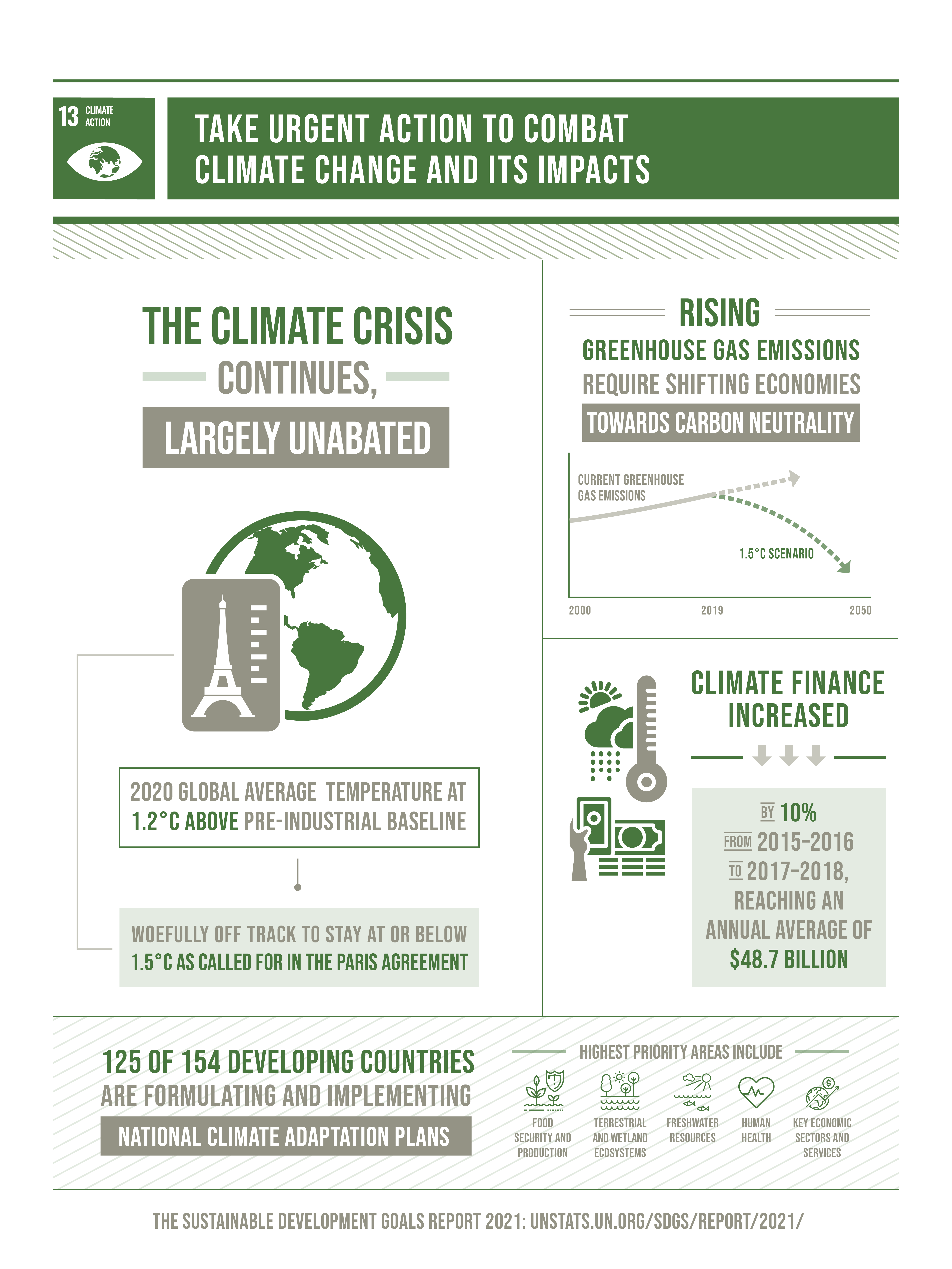



Carbon dioxide (CO2) levels and other greenhouse gases in the atmosphere rose to new records in 2019.
Climate change is affecting every country on every continent. It is disrupting national economies and affecting lives. Weather patterns are changing, sea levels are rising, and weather events are becoming more extreme.
Although greenhouse gas emissions are projected to drop about 6 per cent in 2020 due to travel bans and economic slowdowns resulting from the COVID-19 pandemic, this improvement is only temporary. Climate change is not on pause. Once the global economy begins to recover from the pandemic, emissions are expected to return to higher levels.
Saving lives and livelihoods requires urgent action to address both the pandemic and the climate emergency.
The Paris Agreement, adopted in 2015, aims to strengthen the global response to the threat of climate change by keeping a global temperature rise this century well below 2 degrees Celsius above pre-industrial levels. The agreement also aims to strengthen the ability of countries to deal with the impacts of climate change, through appropriate financial flows, a new technology framework and an enhanced capacity building framework.
Facts and Figures:-
- As of April 2018, 175 parties had ratified the Paris Agreement and 168 parties had communicated their first nationally determined contributions to the UN framework convention on Climate Change Secretariat.
- As of April 2018, 10 developing countries had successfully completed and submitted their first iteration of their national adaptation plans for responding to climate change.
- Developed country parties continue to make progress towards the goal of jointly mobilizing $100 billion annually by 2020 for mitigation actions.
Thanks to the Intergovernmental Panel on Climate Change we know:
- From 1880 to 2012, average global temperature increased by 0.85°C. To put this into perspective, for each 1 degree of temperature increase, grain yields decline by about 5 per cent. Maize, wheat and other major crops have experienced significant yield reductions at the global level of 40 megatons per year between 1981 and 2002 due to a warmer climate.
- **Oceans have warmed, the amounts of snow and ice have diminished and sea level has risen.**From 1901 to 2010, the global average sea level rose by 19 cm as oceans expanded due to warming and ice melted. The Arctic’s sea ice extent has shrunk in every successive decade since 1979, with 1.07 million km² of ice loss every decade
- Given current concentrations and on-going emissions of greenhouse gases, it is likely that by the end of this century, the increase in global temperature will exceed 1.5°C compared to 1850 to 1900 for all but one scenario. The world’s oceans will warm and ice melt will continue. Average sea level rise is predicted as 24 – 30cm by 2065 and 40-63cm by 2100. Most aspects of climate change will persist for many centuries even if emissions are stopped
- Global emissions of carbon dioxide (CO2) have increased by almost 50 per cent since 1990
- Emissions grew more quickly between 2000 and 2010 than in each of the three previous decades
- It is still possible, using a wide array of technological measures and changes in behavior, to limit the increase in global mean temperature to two degrees Celsius above pre-industrial levels
- Major institutional and technological change will give a better than even chance that global warming will not exceed this threshold
13.1 Strengthen resilience and adaptive capacity to climate-related hazards and natural disasters in all countries
13.2 Integrate climate change measures into national policies, strategies and planning
13.3 Improve education, awareness-raising and human and institutional capacity on climate change mitigation, adaptation, impact reduction and early warning
13.A Implement the commitment undertaken by developed-country parties to the United Nations Framework Convention on Climate Change to a goal of mobilizing jointly $100 billion annually by 2020 from all sources to address the needs of developing countries in the context of meaningful mitigation actions and transparency on implementation and fully operationalize the Green Climate Fund through its capitalization as soon as possible
13.B Promote mechanisms for raising capacity for effective climate change-related planning and management in least developed countries and small island developing States, including focusing on women, youth and local and marginalized communities
*Acknowledging that the United Nations Framework Convention on Climate Change is the primary international, intergovernmental forum for negotiating the global response to climate change.
Atmospheric concentrations of the major greenhouse gases continued to increase despite the temporary reduction in emissions in 2020 related to measures taken in response to the COVID-19 pandemic. The six years from 2015 to 2020 are likely to be the warmest on record. Climate change is making the achievement of many Goals less likely. To limit global warming to 1.5°C above pre-industrial levels in accordance with the Paris Agreement, the world would need to achieve net zero carbon dioxide emissions by around 2050.
As of April 2020, 118 countries and territories had reported the development and adoption of national or local disaster risk reduction strategies, an increase from 48 countries and territories in the first year of the Sendai Framework.
As at 31 December 2020, 190 parties (189 countries and territories plus the European Union) had communicated their first nationally determined contribution to the United Nations Framework Convention on Climate Change, of which 44 were least developed countries and 40 were small island developing States. A further 48 countries and territories, of which one is a least developed country and five are small island developing States, have also communicated a second or updated nationally determined contribution. Of these 48 countries and territories, 39 included adaptation information in their new or updated contribution. The nationally determined contributions demonstrate that countries and territories are articulating more quantified targets and indicators for adaptation and identifying links between adaptation, the Goals and other frameworks.
As at 31 March 2021, 125 of 154 developing countries were carrying out measures for national adaptation plans and prioritizing the formulation and implementation of the plans in their adaptation efforts. Moreover, six least developed countries (including three small island developing States) and another four small island developing States have completed a national adaptation plan. Further least developed countries have draft national adaptation plans and are on track to complete and submit these with a view to ensuring that all least developed countries have national adaptation plans by 2021.
According to scientists, global emissions should be cut to 45 per cent below 2010 levels by 2030 in order to limit global warming to 1.5°C above pre -industrial levels. Emissions from developed countries were approximately 6.2 per cent lower in 2019 than in 2010, while emissions from 70 developing countries rose by 14.4 per cent in 2014.
Total climate finance reported by States parties included in annex I to the Framework Convention on Climate Change continues to increase, reaching an annual average of $48.7 billion in the period 2017–2018. This represents an increase of 10 per cent compared to the 2015–2016 period. While more than half of all climatespecific financial support in the 2017 and 2018 was targeted at mitigation action, the share of adaptation support is growing, and many countries and territories are prioritizing adaptation in their financial support provision.
If left unchecked, climate change will cause average global temperatures to increase beyond 3°C, and will adversely affect every ecosystem. Already, we are seeing how climate change can exacerbate storms and disasters, and threats such as food and water scarcity, which can lead to conflict. Doing nothing will end up costing us a lot more than if we take action now. We have an opportunity to take actions that will lead to more jobs, great prosperity, and better lives for all while reducing greenhouse gas emissions and building climate resilience.
There are many things that each of us can do as individuals. To preserve a livable climate, greenhouse-gas emissions must be reduced to net zero by 2050. Bold, fast, and wide-ranging action needs to be taken by governments and businesses. But the transition to a low-carbon world also requires the participation of citizens – especially in advanced economies.
ActNow is the United Nations campaign for individual action on climate change and sustainability.
Every one of us can help limit global warming and take care of our planet. By making choices that have less harmful effects on the environment, we can be part of the solution and influence change.
Source:- www.un.org